Related Research Articles

Electronic art is a form of art that makes use of electronic media. More broadly, it refers to technology and/or electronic media. It is related to information art, new media art, video art, digital art, interactive art, internet art, and electronic music. It is considered an outgrowth of conceptual art and systems art.
Information art, which is also known as informatism or data art, is an emerging art form that is inspired by and principally incorporates data, computer science, information technology, artificial intelligence, and related data-driven fields. The information revolution has resulted in over-abundant data that are critical in a wide range of areas, from the Internet to healthcare systems. Related to conceptual art, electronic art and new media art, informatism considers this new technological, economical, and cultural paradigm shift, such that artworks may provide social commentaries, synthesize multiple disciplines, and develop new aesthetics. Realization of information art often take, although not necessarily, interdisciplinary and multidisciplinary approaches incorporating visual, audio, data analysis, performance, and others. Furthermore, physical and virtual installations involving informatism often provide human-computer interaction that generate artistic contents based on the processing of large amounts of data.

Frank Joseph Malina was an American aeronautical engineer and painter, especially known for becoming both a pioneer in the art world and the realm of scientific engineering.
George Gessert is one of the best-known artists in the contemporary art movement known as bio-art a/k/a BioArt. Gessert began his career as a painter and printmaker, and began breeding plants as an art form in the late 1970s. Beginning in the 1980s, Gessert's work focused on the overlap between art and genetics, and he has exhibited a series of installations of hybrids and documentation of breeding projects.
Kenneth E. Rinaldo is an American neo-conceptual artist and arts educator, known for his interactive robotics, 3D animation, and BioArt installations. His works include Autopoiesis (2000), and Augmented Fish Reality (2004), a fish-driven robot.
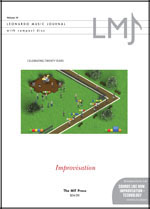
Leonardo Music Journal is an annual multimedia peer-reviewed academic journal published by the MIT Press on behalf of Leonardo, The International Society of the Arts, Sciences and Technology. The journal was established in 1991 and publishes the work of artists who are inventing media, implementing developing technologies, and expanding the boundaries of radical and experimental aesthetics. The journal is a companion volume to Leonardo. The editor-in-chief is Roger Malina.

BioArt is an art practice where artists work with biology, live tissues, bacteria, living organisms, and life processes. Using scientific processes and practices such as biology and life science practices, microscopy, and biotechnology the artworks are produced in laboratories, galleries, or artists' studios. The scope of BioArt is a range considered by some artists to be strictly limited to "living forms", while other artists include art that uses the imagery of contemporary medicine and biological research, or require that it address a controversy or blind spot posed by the very character of the life sciences.

Mary Flanagan is an artist, author, educator, and designer. She pioneered the field of game research with her ideas on critical play and has written five books. She is the founding director of the research laboratory and design studio Tiltfactor Lab and the CEO of the board game company Resonym. Flanagan's work as an artist has been shown around the world and won the Award of Distinction at Prix Ars Electronica in 2018.
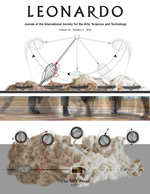
Leonardo is a peer-reviewed academic journal published by the MIT Press covering the application of contemporary science and technology to the arts and music.

Hybrid art is a contemporary art movement in which artists work with frontier areas of science and emerging technologies. Artists work with fields such as biology, robotics, physical sciences, experimental interface technologies, artificial intelligence, and information visualization. They address the research in many ways such as undertaking new research agendas, visualizing results in new ways, or critiquing the social implications of the research. The worldwide community has developed new kinds of art festivals, information sources, organizations, and university programs to explore these new arts.

Roger Malina is an American physicist, astronomer, Executive Editor of Leonardo Publications by Leonardo, the International Society of Arts, Sciences and Technology and distinguished professor of arts and technology, and professor of physics at the University of Texas at Dallas.

Ricardo Mbarkho, is a Lebanese contemporary artist, researcher, and assistant professor.
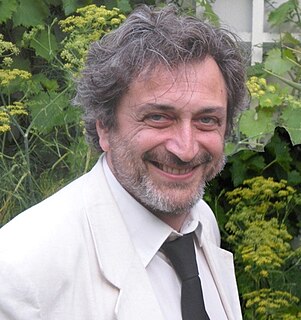
Pier Luigi Capucci is an Italian educator, theorist and writer in the fields of media and of the relationships among culture, sciences and technologies, as well as an active contributor to the international debate about culture-sciences-technologies-arts.

Victoria Vesna is a professor and digital media artist. She is known for her feminist video, computer and internet art and has been active since the early 1980s. Along with collaborator Jim Gimzewski she is thought to have created one of the first interactive artworks related to nanotechnology and defines her art practice as experimental research.
Christine Yvonne Malina-Maxwell is a British Internet content pioneer and educator, best known as the creator and co-founder of Magellan. Maxwell also co-founded the software company Chiliad and is the author of several books. She is the Program Manager of Learning Technologies at the University of Texas at Dallas.
Annette Louise Barbier was an American artist and educator. She worked with video art, net art, installation art, interactive performance, and emerging and experimental technologies since the 1970s. Themes in her work address "issues of home, defined locally as domesticity and more broadly as the ways in which we relate to our environment." An early work, "Home Invasion [1995]," incorporating critical dialogue and audio, is accessible from Leonardo. "Domestic space—formerly inviolable—is increasingly disrupted by electronic communication of all sorts, including radio, TV, email and the telephone." She was Chicago-based.

Nina Czegledy is a Canadian artist, new media art curator and writer.
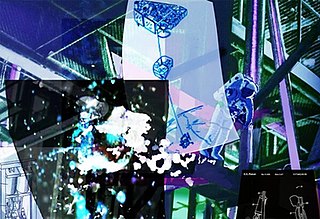
Ellen K. Levy is an American multimedia artist and scholar known for exploring art, science and technology interrelationships since the early 1980s. Levy works to highlight their importance through exhibitions, educational programs, publications and curatorial opportunities; often through collaborations with scientists including NASA, some in conjunction with Leonardo, the International Society for the Arts, Sciences and Technology. She is a past president of the College Art Association and has published widely on art and complex systems.
Monika Fleischmann is a pioneering German research artist, digital media scientist, and curator of new media art. She is one of the most relevant European women artist working in art, science, and technology. She founded and co-founded departments for interactive media art such as ART+COM in Berlin, the MARS – Exploratory Media Lab and the eCulture Factory within the largest German research institutions such as GMD and Fraunhofer Society. In 1992, together with her partner Wolfgang Strauss, she received the Golden Nica of the Prix Ars Electronica in Linz, Austria for Home of the Brain (1990/1992), the first artistic virtual reality installation. She is the recipient of the 2018 ACM SIGGRAPH Distinguished Artist Award for Lifetime Achievement in Digital Art and was elected to the SIGGRAPH Academy as a research artist that has contributed to the field of interactive media art since the 1980s to the present day. Since the mid-1980s she has been working collaboratively with the architect Wolfgang Strauss as an artist couple. As part of their research in New Media Art, Architecture, Interface Design and Art Theory, they focus on the concept of Mixed Reality, which connects the physical with the virtual world. In 2008 she was appointed Honorary Professor of Media Theory and Interactive Media Art for the cross-university course of studies for digital media at Bremen University of Applied Sciences, Academy of Fine Arts and University of Bremen. Monika is Member of the MIMA ART Board at MIMA University | Munich Institute of Media and Musical Arts.
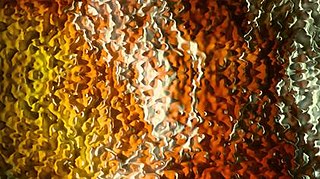
Patricia Olynyk is a Canadian born American multimedia artist, scholar and educator whose work explores art, science, and technology-related themes. Known for collaborating across disciplines and projects that explore the mind-brain relationship, interspecies communication and the phenomenology of perception, her work examines "the way that experiences and biases toward scientific subjects affect interpretations in specific contexts."
References
- ↑ "report - CharityCheck101.org". CharityCheck101.org. Retrieved 2018-03-19.
- ↑ "Leonardo: The International Society for the Arts, Sciences and Technology". Leonardo. 33 (5): 451–452. 2006-03-13. doi:10.1162/002409400552793.
- ↑ "Home". Leonardo/ISAST. Retrieved 2018-03-19.
- ↑ "Prix Forum IV - Visionary Pioneers of Media Art / Leonardo Birthday Party". Error. Retrieved 2019-08-08.
- ↑ "Ars Electronica Archiv". archive.aec.at. Retrieved 2019-08-08.
- ↑ "Leonardo/ISAST". Error. Retrieved 2019-08-08.
- ↑ "Our History". Leonardo/ISAST.
- ↑ Carrier, David (2008-01-14). "Leonardo and Leonardo da Vinci". Leonardo. 41 (1): 36–38. doi:10.1162/leon.2008.41.1.36.
- ↑ "Leonardo/International Society for the Arts, Sciences and Technology | Yearbook Profile | Union of International Associations". uia.org. Retrieved 2018-03-19.
- ↑ Harris, Craig; Maun, Patrick (2006-03-13). "Introduction: Leonardo Electronic Almanac". Leonardo. 32 (4): 245–247. doi:10.1162/002409499553271.
- ↑ "Leonardo Book Series | The MIT Press". MIT Press. Retrieved 2018-03-19.
- ↑ "| Leonardo/ISAST". Leonardo/ISAST. Retrieved 2018-03-19.
- ↑ "LABS – Leonardo ABstracts Service". collections.pomona.edu. Retrieved 2018-03-19.
- ↑ "Penny to give WNY's first LASER Talk". www.buffalo.edu. Retrieved 2019-01-18.
- ↑ Stuart, By S. C. (June 19, 2018). "Why Everything Elon Musk Fears About AI Is Wrong". PCMag. Retrieved 2019-01-18.
- ↑ "Djerassi Resident Artists Program | Scientific Delirium Madness". Djerassi Resident Artists Program. Retrieved 2018-03-19.
- ↑ "LASER Talks in New York City". leonardo.info. Leonardo/The International Society for the Arts, Sciences and Technology (Leonardo/ISAST), MIT Press. Retrieved 22 June 2020.
- ↑ "Leonardo Education and Art Forum Chair Ellen K. Levy". Leonardo. 43 (5): 518. 2010. doi:10.1162/LEON_a_00069.